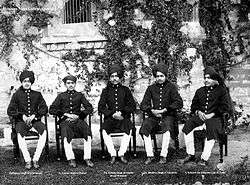Pagri (turban)
Pagari (Hindi: पगड़ी, Bengali: পাগড়ি, Marathi: पगडी, Gujarati: પાઘડી, Punjabi: ਪੱਗ, Urdu: پگڑی), sometimes also transliterated as pagari, is the term for turban originating in the Indian subcontinent. It specifically refers to a headdress that is worn by men and women, which needs to be manually tied. Other names include sapho (Gujarati: સાફો) and fagri (Sylheti: ꠚꠣꠉ꠆ꠠꠤ).
_(8411728143).jpg)
All people of Maithili speaking area wear turban (PAGARI). The Pagari is prevalent in Mithila region since time immemorial. Except Brahmins and Kayastha, all other people from all other caste and community wear Pagari (turban). The people of Yadav, Teli, Sudhi, Kalbar, Dusadh, Mochi etc are used Pagari in mithila . Pagari is their identity. Solakan, Pichhdaavarg, Backward etc wear Pagari . The Brahmin people are forced to wearing their identity on other caste. People are opposing this activities in Mithila .In Mithila Pagari is also known as Pagadi .
Cloth
A pagri is usually a long plain unstitched cloth. The length may vary according to the type. The cloth indicates the region and the community of the wearer.[1]
Specific styles
Paag
The paag is a headdress in the Mithila region of Bihar and in Mithila, Nepal and is worn by Maithil Brahman and Karna-Kayastha people.Paag is not the dress of everyone in the Maithili speaking region. The tradition of applying Paag in the Maithili region is in Brahmin and Karna Kayastha. Folk of other caste do not wear Paag. Brahminical sub-clans are being attacked by other caste communities in the Maithili speaking region. This is Brahmin expansionism. In Mithila region, there is a desire to wear a Pagadi or a Muretha. People of all castes apply it. Brahmins and Karna-Kayasthas wear their Paag on the occasion of their Upanayana, marriage. Now it is being forced on the forehead to all people by Brahmin .
Pheta
Pheta is the Marathi name for the traditional turban worn in Maharashtra, India. In ceremonies such as weddings, festive and cultural and religious celebrations as well it is common to wear Pheta. In many parts it is customary to offer male dignitaries a traditional welcome by offering a Pheta to wear. A traditional Pheta is usually long cloth typically 3.5 to 6 meters long and 1 meter wide. The choice of colour may indicate the occasion for which it is being worn and also may be typical to the place it is being worn in. Typical colours include Saffron (to indicate valour) and White (to indicate peace). In the past, wearing a Pheta was considered a mandatory part of clothing.[2]
There are several styles of Pheta which are specific to regions, for example
- Kolhapuri and Puneri pheta
- Mawali pagadi (traditionally worn by Maratha warriors from the Mawal region of Maharashtra)
- Mahatma Phule pagadi famously worn by the Maharashtrian reformer, the activist from whom it gets the name.[3]
Peta
The peta is a turban worn in Mysore and Kodagu, it is the traditional indigenous attire worn by the erstwhile Kings of Mysore, called the Wodeyars (1399 to 1947), of the Kingdom of Mysore. Wodeyars wore a richly bejeweled turban made of silk and jari (gold threaded lace) to match with colorful dresses as part of the royal dress.
Administrators under the King, such as the Dewans' (Prime Minister appointed by the King) and other senior officials who swayed considerable power in matters of state administration also doffed the Mysore peta.
After India became independent in 1947 and the princely state merged with the Indian union, the traditional Mysore peta has been retained as a symbol of heritage and cultural antecedents and distinguished people are honoured by the award of a Mysore peta with a shawl in formal functions.
Rajasthani pagari

Turbans worn in Rajasthan are referred to as the pagari. They vary in style, colour and size. They also indicate a wearer's social class, caste, region and the occasion it being worn for. Its shape and size may also vary with the climatic conditions of the different regions. Turbans in the hot desert areas are large and loose. Farmers and shepherds, who need constant protection from the elements of nature, wear some of the biggest turbans. The Rajasthani turban also has many practical functions. Exhausted travellers use it as a pillow, a blanket or a towel. It can be used to strain muddy water. An unravelled turban can also be used as a rope to draw water from a well with a bucket.[4]
Prominent styles are pencha, sela and safa, although several local variants exist. A conventional pagari is usually 82 inches long and 8 inches wide. A Safa is shorter and broader. Ordinarily a turban of a single colour is worn. However, turbans of one of more colours may be worn by the elite or during special occasions such as festivals or weddings, etc.[5] Rajasthani turbans are a prominent tourist attraction. Tourists are often encouraged to participate in turban-tying competitions.[4]
Dastar
A dastar is a pagri worn by Sikhs. It is mandatory for all Khalsas, i.e., Amritdhari (Initiated) Sikhs, to wear one. Styles may vary between different Sikh orders and regions. A Sikh turban plays an important part of the unique Sikh identity. It is worn to cover the long, uncut hair (termed kesh) that is one of the five outward symbols ordered by Guru Gobind Singh as a means to profess the Khalsa Sikh faith. The most commonly worn styles of dastar include PatialaShahi dastar, Morni/Pochvi dastar, Amritsar Shahi dastar, Canadian style and many more regional. In Punjabi dialects pagri is often shortened to pagg.
Peshawari pagri
Peshawari pagri has been traditionally worn in Peshawar. It includes a cap called kulla and the cloth wrapped around it called lungi.[6]
Waiters' turban
In several Indian Coffee Houses and restaurants waiters wear turbans with a fan-like attachment on the side.
A symbol of honour
A pagri is a symbol of honour and respect in all the regions where it is a practice to wear one.
Association with figure of speech
A pagri's association with honour also lends its use in a figure of speech in associated languages. The figure of speech pagri uchaalna in Hindi (literal translation: to toss the turban) implies causing the loss of honour.
Pagri in Ancient India: from major museums
 Bharhut, Freer Gallery, Shunga period
Bharhut, Freer Gallery, Shunga period- The Great Departure of Buddha, Victoria and Albert Museum
- Proto-Pagri, Kushan-Gupta period, 5th-6th century CE, terracotta, Honolulu Academy of Arts


 Walters Art Museum, Baltimore
Walters Art Museum, Baltimore
References
- "Pride of tying Turbans". Travelersindia.com.
- "Kolhapuri Pheta". Kolhapur World. Archived from the original on 2012-10-02.
- "From baseball caps to phetas!".
- "Rajasthan at a glance". Rajasthanunlimited.com. Archived from the original on 2012-12-12. Retrieved 2010-03-03.
- "Rajasthan traditional dresses". greatindianholiday.com. Archived from the original on 2009-09-18. Retrieved 2010-03-03.
- Title Subhas Chandra Bose: Netaji's passage to im[m]ortality, Subodh Markandeya, Arnold Publishers, 1990, p. 147
